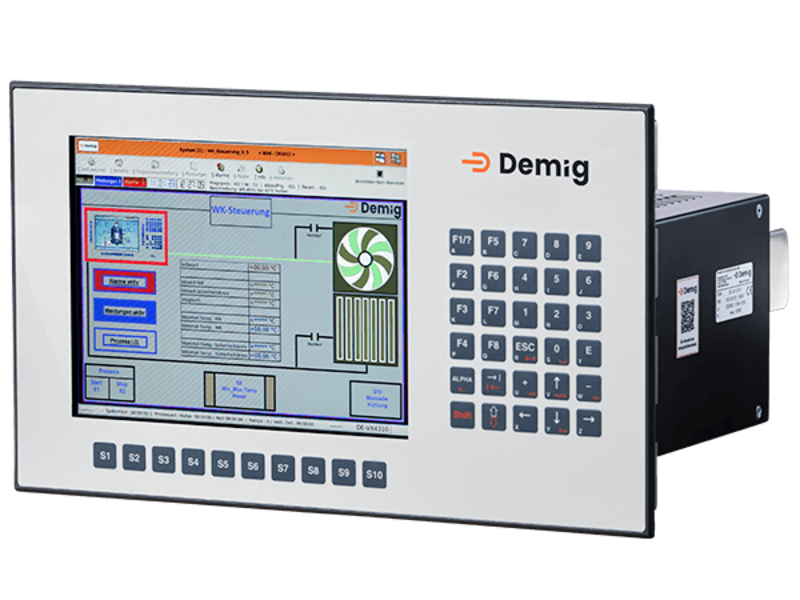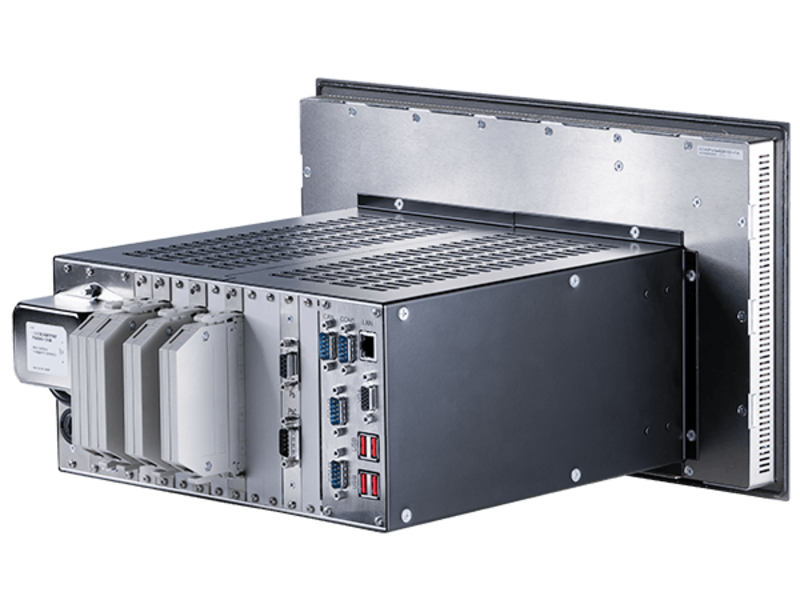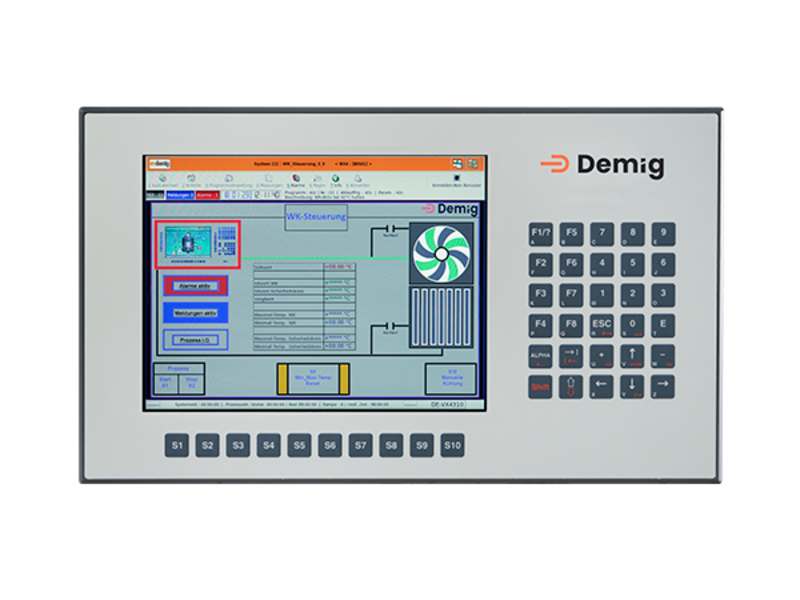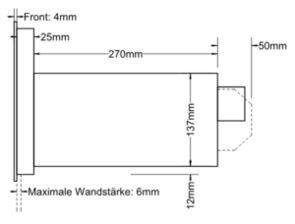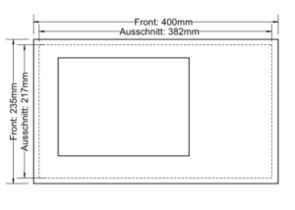The Demig DE-VX 4310 Series
Convenient & intuitive
DE-VX 4310 Series process controllers have been available since May of 2022 as the technical successor to our successful DE- VX 4100/4200 Series. Technical hardware updates (such as CPU, memory) and a fully redesigned graphic interface based around the operating concept of our control system were included in the development. Of course, it remains compatible to current and previous Demig device generations.
The 10" display variant with membrane keypad, combined with a high-performance processor, delivers quick image composition with either a new, convenient/intuitive interface or the trusted classic interface for the user. This allows for complex graphic displays of system diagrams and procedures. All models are designed as a flat version for optimal installation. Replacement frames make it possible to update existing systems without having to change the switch cabinet cut-out.

Your advantages at a glance
Functional description
Operation
- Simple, intuitive menu-guided operation via keyboard and freely programmable special keys
- Process-oriented programming
- Switch language in the menu
- Custom configuration options for system designers
Technology
- Convenient process visualisation with a high-resolution 10" display
- Quick reaction times for controlling and image composition thanks to the Intel Atom processor
- Network capable via Gigabit Ethernet
- CAN Bus and Profibus (Slave/Master) connection possible
- Remote communication via modem for monitoring and maintenance
- Hardware watchdog for digital and analogue outputs and for the overall system
- Flush-mount case for control panel with seal on the front, protection level IP65
Data recording
- Recording of all process variables
- Integrated write function
- Graphic and numerical data output
- Print functions
- Quality certification under DIN ISO 9000
Regulation
- Multi-system regulation
- All standard control algorithms with parameter switching and setpoint correction
- Special functions (such as diffusion processes, F value calculation)
Controlling
- Integrated PLC (S5© and S7© compatible)
- Manual operating mode
- Sequence control
- Special functions (such as impulse firing system)
Visualisation
- Process view(s) with status display
- Alarm and report display with help function
- Online process variable illustration, numerical and as a trend display
Technical data
System computer – Unit
- Industrial computer with high-performance processor
- Integrated PLC, S5© and S7© compatible instruction set, max. PLC program length: 60,000 commands with time requirement for 1,000 Bit commands of < 0.2 ms
up to 256 timers, 1024 messages, 1024 alarms (optional switch-on delay)
Memory
- 2 GB working memory
- 8 GB flash memory for operating program and configuration memory
- 4 MB SRAM (battery-buffered for current process status. Treatment programs and measured data recording)
Interfaces/connections
All interfaces (incl. USB) are insulated from the supply and system potential.
- COM1 DIN-RS232 (galvanically isolated)
- COM2 DIN-RS232/RS422/RS485 (galvanically isolated and with software-controlled termination)
- COM3 DIN-RS232/RS422/RS485 (galvanically isolated and with software-controlled termination)
- 4 USB interfaces (galvanically isolated) for external keyboard, mouse, printer, etc.
- 1 X Gigabit Ethernet, TCP/IP protocol for configuration, remote control, control system connection, Modbus/TCP, Auto MDI-X
- Logs e.g. RK 512, Modbus, 3964R
- (Optional) CAN-Bus to connect external modules
- Power supply input voltage range from 110V AC to 230V AC, 50 – 63 Hz
- Profibus-DP-Slave (optional) (EN 50 170/DIN 19245 Part 1) 9.6Kbit/s-12Mbit/s, automatic bit rate detection,
E/A RS 485 wiring, DSUB-9 connector, maximum 244 bytes each input and output data - Profibus-DP-Master (optional) (EN 50 170/DIN 19245 Part 1) to connect up to 125 slaves, 9.6Kbit/s-12Mbit/s, automatic bit rate detection, E/A RS 485 wiring, DSUB-9 connector, maximum 512 bytes each input and output data. Configuration via external PC software (must be ordered separately).
Display
- 10.4″ TFT LCD colour display with extra large viewing angle, XGA resolution (1024×768 Pixel)
- Standard VGA interface for optional auxiliary motor
Operation
- Membrane keypad (according to DIN EN 60529, protection level IP 65 with Alpha key function
- Externally connectable USB keyboard
- Externally connectable USB mouse
- Programmable special keys
- Unicode language support
- Multiple language switches during running time
Safety.
- Double safety function with global and local watchdog functions
- Power failure monitoring
- Copy and knowledge protection
Installation
- Front plate with integrated seal IP65
- Ambient operating temperature 0…+45°C
- Relative humidity 0…90% non-condensing at +40°C and under 3000m
- Storage temperature -20…+60°C
- Overvoltage category III (according to DIN EN 60664-1)
- Degree of contamination 2 (according to DIN EN 60664-1)
Inputs/outputs (each max. extension indicated)
| Internal: | incl. CAN Bus: | |
|---|---|---|
| Analogue inputs: | 128 | 128 |
| Analogue outputs: | 64 | 96 |
| Digital inputs: | 256 | 512 |
| Digital outputs: | 256 | 512 |
Programmer/controller (max. extension)
- Setpoints: 192
- Control tracks: 512
- Loops: 1,024
- Limit values: 1.024
- Alarms: 1,024 (switch-on delay) with alarm history
- Systems: 8 independent systems configurable
- Recorder: 64 process variables can be recorded
Accessories
Technical data I/O cards
| Article | Designation | Art. no. |
|---|---|---|
| AD8 | 8x analogue input card (max. 64 inputs) | 601613 |
| DA8 | 8x analogue output card (resolution 12 Bit) | 601615 |
| AD 4/DA 2 | 4x IN/2x OUT analogue combi | 601614 |
| AD 4/DA 2G | 4x IN/2x OUT analogue combi (with limit value switch) | 601616 |
| IN 32 | 32x digital input card | 601611 |
| OUT 32 | 32x digital output card (transistor) | 601612 |
| IN24 /OUT 16 | 24x Digital IN/16x digital OUT card (transistor) | 601608 |
| Profibus DP Master | Profibus DP Master | 601837 |
| Profibus DP Slave | Profibus DP Slave | 601821 |
| Mounting kit | Mounting kit to panel housing | 394210 |
| Adapter frame | Adapter frame | 390998 |
| Adapter frame | Adapter frame mounting kit | 390401 |
AD8: 8X analogue input card
Article number: 601613
- All inputs are galvanically isolated from one another and the system potential
- DC voltage, direct current measurement possible
- Inputs configurable: 0…100mV 0…500mV
- 0…2V 0…10V
- 0…20mA
- 0…400 Ω (2/3/4 conductor technology)
- Error < 0.1% of measurement range
- Any combination of input writing
- Min. measurement time per channel 20mS
- Double comparison point measurement in the connection plug
Linearisation is included in the scope of delivery for the following thermal elements:
- Cu-CuNi type U ( -200 … +600 °C)
- Fe-CuNi type L ( -200 … +900 °C)
- NiCr-CuNi type E ( 0 … +1000 °C)
- Ni-CrNi type K ( -200 … +1370 °C)
- PtRh-AuPdPt ( -100 … +1300 °C)
- PtRh13-Pt type R ( 0 … +1740 °C)
- PtRh10-Pt type S ( 0 … +1760 °C)
- PtRh30-PtRh6 type B ( 0 … +1800 °C)
- WRe3-WRe25 ( 0 … +2400 °C)
- WRe3-WRe26 ( 0 … +2500 °C)
- NiCrSi-NiSi type N ( -270 … +1400 °C)
- in addition to Pt 100 ( -200 … +800 °C)
- Separate linearisations and calculations configurable
DA8: 8X analogue output card
Article number: 601615
- All outputs are galvanically isolated from the system potential
- Outputs: 0…10V power rating >= 1k Ω
- 0(4)…20mA load <= 1000 Ω
- Resolution 12 Bit/0.025%
- Output rate dependent on configuration (min. every 100ms).
- Local watchdog function integrated
AD4/DA2: Analogue combi card
Article number: 601614
Analogue inputs (4):
- All inputs are galvanically isolated from one another and the system potential
- DC voltage, direct current measurement possible
- Inputs configurable: 0…100mV 0…500mV
- 0…2V 0…10V
- 0…20mA
- 0…400 Ω (2/3/4 conductor technology)
- Error < 0.1% of measurement range
- Any combination of input writing via configuration software
- Min. measurement time per channel 20mS
- Comparison point measurement in the connection plug
Linearisation is included in the scope of delivery for the following thermal elements:
- Cu-CuNi type U ( -200 … +600 °C)
- Fe-CuNi type L ( -200 … +900 °C)
- NiCr-CuNi type E ( 0 … +1000 °C)
- Ni-CrNi type K ( -200 … +1370 °C)
- PtRh-AuPdPt ( -100 … +1300 °C)
- PtRh13-Pt type R ( 0 … +1740 °C)
- PtRh10-Pt type S ( 0 … +1760 °C)
- PtRh30-PtRh6 type B ( 0 … +1800 °C)
- WRe3-WRe25 ( 0 … +2400 °C)
- WRe3-WRe26 ( 0 … +2500 °C)
- NiCrSi-NiSi type N ( -270 … +1400 °C)
- in addition to Pt 100 ( -200 … +800 °C)
- Separate linearisations and calculations configurable
Analogue outputs (2):
- All outputs are galvanically isolated from the system potential
- Outputs: 0…10V power rating >= 1k Ω
- 0(4)…20mA load <= 500 Ω
- Resolution 12 Bit/0.025%
- Output rate dependent on configuration (min. every 100ms).
- Local watchdog function integrated
AD4/DA2: Analogue combi card with limit value switch
Article number: 601616
Like article 601614 with the following addition
Comparator inputs (2):
- The two inputs 0 ... 10V are on the potential of the analogue outputs, and are compared with one another internally.
- Potential-free relay output switches depending on the result of the comparator.
IN32: 32x digital input card
Article number: 601611
- All inputs are galvanically isolated from the system potential by optocouplers
- Input potential 0V…30V (DC); logical 0 < 5V logisch 1 > 15V
- Hardware debouncing of all inputs, signal length either 1.6ms/0.14ms
(longer or shorter signal lengths possible upon request)
OUT32: 32x digital output card
Article number: 601612
- All outputs are galvanically isolated from the system potential by optocouplers
- Switching capacity per output max. 30V/max. 0.5A at max. 12W (resistive load)
- External power supply to the output transistors 24V DC ± 15%
- Local watchdog function integrated
IN24/OUT16: 24x IN/16x OUT card
Article number 601608
- All inputs are galvanically isolated from the system potential by optocouplers
- Input potential 0V…30V (DC) 15mA; logical 0 < 6V logisch 1 > 10V
- Hardware debouncing of all inputs, min. signal length 200ms
(shorter signal lengths possible upon request) - All outputs can handle a load of 0.5A (all outputs can be switched on at the same time)
- Short circuit resistance for all outputs
- Supply voltage 18VDC..36VDC
- Local watchdog function integrated
- Outputs are switched off when the supply voltage is < 16V
Profibus Master
Article number 601837
- EN 50 170/DIN 19245 Part 1
- To connect up to 125 slaves,
- 9.6Kbit/s- 12Mbit/s, automatic bit rate detection,
- E/A RS 485 wiring, DSUB-9 connectors galvanically isolated.
- Maximum 512 bytes each of input and output data.
- Configuration via external software
Profibus Slave
Article number 601821
- EN 50 170/DIN 19245 Part 1
- 9.6Kbit/s- 12Mbit/s, automatic bit rate detection,
- E/A RS 485 wiring, DSUB-9 connectors, galvanically isolated.
- Maximum 244 bytes each of input and output data
Auxiliary modules
Online diffusion calculation
(also releases the diffusion simulation in prosys/2)
Iron + carbon equals steel At a temperature between 911°C and 1392°C, the lattice changes from a body-centred cubic phase to a face-centred cubic phase. The lattice is also in a body-centred cubic phase above this temperature, but the spacing is greater compared to temperatures below 911°C.
Carbon is an important component of steel alloys, and plays a key role in adjusting component characteristics. The process of carburisation is used to adjust component characteristics in a targeted manner through partial edge carburisation. This process is particularly important, since it increases the strength and hardness of the steel.
Nitriding calculation
Nitriding processes are used to harden the surfaces of steel and other iron materials through diffusing nitrogen into the surface of a metal.
Nitrocarburising is a combination of nitriding and carburisation (e.g. diffusion of carbon). During this process, the workpiece is exposed to ammonia at temperatures of approx. 500°C to 600°C (with an added gas containing carbon during nitrocarburising, such as carbon monoxide, carbon dioxide, propane, etc.). The ammonia or added gas divides partially on the surface of the workpiece; the atomic nitrogen (or carbon) is diffused in the workpiece and forms a hardened layer. The hydrogen released during nitriding comes out of the furnace along with the undivided ammonia and is burned off.
Direct coupling of lambda sensors
A lambda sensor is a technical component for heating systems that measures the residual oxygen content in the hot exhaust gases. This value can be used to achieve an optimal mixture of combustion air and flue gases in the combustion chamber, resulting in optimal combustion and reducing emissions.
Measurements


